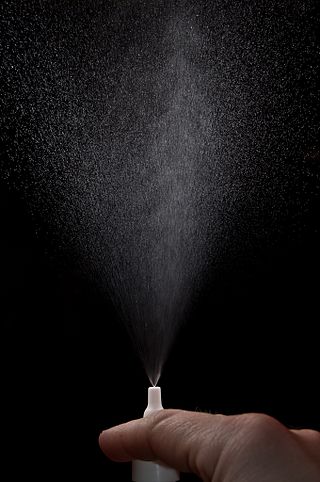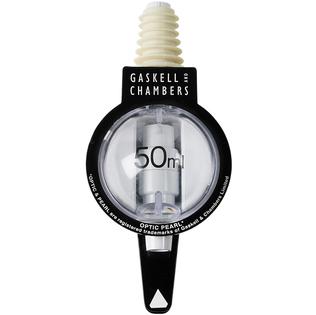
A pipette is a type of laboratory tool commonly used in chemistry and biology to transport a measured volume of liquid, often as a media dispenser. Pipettes come in several designs for various purposes with differing levels of accuracy and precision, from single piece glass pipettes to more complex adjustable or electronic pipettes. Many pipette types work by creating a partial vacuum above the liquid-holding chamber and selectively releasing this vacuum to draw up and dispense liquid. Measurement accuracy varies greatly depending on the instrument.

An espresso machine brews coffee by forcing pressurized water near boiling point through a "puck" of ground coffee and a filter in order to produce a thick, concentrated coffee called espresso. Multiple machine designs have been created to produce espresso. Several machines share some common elements, such as a grouphead and a portafilter. An espresso machine may also have a steam wand which is used to steam and froth liquids for coffee drinks such as cappuccino and caffè latte.

A water gun is a type of toy gun designed to shoot jets of water. Similar to water balloons, the primary purpose of the toy is to soak another person in a recreational game such as water fight.

Aerosol spray is a type of dispensing system which creates an aerosol mist of liquid particles. It comprises a can or bottle that contains a payload, and a propellant under pressure. When the container's valve is opened, the payload is forced out of a small opening and emerges as an aerosol or mist.

A water dispenser, sometimes referred to as a water cooler, is a machine that dispenses and often also cools or heats up water with a refrigeration unit. It is commonly located near the restroom due to closer access to plumbing. A drain line is also provided from the water cooler into the sewer system.

Hydraulic machines use liquid fluid power to perform work. Heavy construction vehicles are a common example. In this type of machine, hydraulic fluid is pumped to various hydraulic motors and hydraulic cylinders throughout the machine and becomes pressurized according to the resistance present. The fluid is controlled directly or automatically by control valves and distributed through hoses, tubes, or pipes.

A spray bottle is a bottle that can squirt, spray or mist fluids.

A Cornelius keg is a stainless steel canister (keg) originally used as containers by the soft drink industry. They can be used to store and dispense carbonated or nitrogenated liquids. Cornelius kegs were originally made by Cornelius, Inc.

The toothpaste pump, also known as a toothpaste pump dispenser, is a device used to contain and dispense toothpaste, akin to a tube. An automatic toothpaste dispenser is a self-starting way to dispense toothpaste.

An instant hot water dispenser or boiling water tap is an appliance that dispenses water at about 94 °C (201 °F) (near-boiling). There are hot-only and hot and cool water models, and the water may be filtered as well as heated. Instant hot water dispensers became popular in the 1970s. Instant hot water dispensers are very similar to portable shower devices; the latter is fitted with a heating element and quickly heats up water, once a switch has been activated.

Drum pump, barrel pump, and transfer pump refer to pumps that are used to empty barrels, tanks, IBCs and drums. Many liquids used on manufacturing and processing plants are delivered in 100 or 200 litre barrels and are too heavy to tip to empty the liquids inside. Drum pumps range from simple siphon based devices to sophisticated highly-engineered machinery.

Alcoholic spirits measures are instruments designed to measure exact amounts or shots of alcoholic spirits. One of the benefits of alcoholic spirits measures is that they can help to control and monitor alcohol consumption and estimated blood alcohol content.

A squeeze bottle is a type of container such as a plastic bottle for dispensing a fluid, that is powered by squeezing the container by exerting pressure with the user's hand. Its fundamental characteristic is that manual pressure applied to a resilient hollow body is harnessed to compress fluid within it and thereby expel the fluid through some form of nozzle.

An automatic soap dispenser is a device that dispenses a controlled amount of soap solution. They are often used in conjunction with automatic faucets in public restrooms. They function to conserve the amount of soap used and stem infectious disease transmission.
Reverse pipetting is a technique to dispense a measured quantity of liquid by means of air displacement pipette. The technique is mainly recommended for solutions with a high viscosity or a tendency to foam: as it reduces the risk of splashing, foam or bubble formation. Reverse pipetting is more precise in dispensing small volumes of liquids containing proteins and biological solutions compared to forward pipetting, which is mostly used for aqueous solutions, such as buffers, diluted acids or alkalis.

A media dispenser or a culture media dispenser is a device for repeatedly delivering small fixed volumes of liquid such as a laboratory growth medium like molten agar or caustic or volatile solvents like toluene into a series of receptacles. It is often important that such dispensers operate without biological or chemical contamination, and so must be internally sealed from the environment and designed for easy cleaning and sterilization before use. At a minimum, a media dispenser consists of some kind of pump connected to a length of discharge tubing or a spout. Dispensers used in laboratories are also frequently connected to microcontrollers to regulate the speed and volume of the medium as it leaves the pump.

A foam pump, or squeeze foamer and dispensing device is a non-aerosol way of dispensing liquid materials. The foam pump outputs the liquid in the form of foam and it is operated by squeezing. The parts of the foam pump, mostly made from polypropylene (PP), are similar to those of other pump devices. The foaming pump often comes with a protective cap.
The Remington Model 878, also known as the 878 Automaster, is a gas-operated semi-automatic shotgun made by Remington Arms from 1959 to 1963. The Model 878 was based on the company's previously introduced Model 58, both of which were succeeded by the Model 1100.

Rubber bulbs are used in chemistry laboratories, by placing them on top of a glass or plastic tube. It serves as a vacuum source for filling reagents through a pipette or pasteur pipette and also help control the flow of liquid from the dropping bottle. By using rubber bulb, the contact of the mouth to the chemicals can be avoided. These rubber rods come in different shapes, sizes and colors.

A pump dispenser is used on containers of liquids to help dispensing. They might be used on bottles, jars, or tubes. Often the contents are viscous liquids such as creams and lotions. Some are metered to provide uniform usage. Some mix contents from two or more sources prior to dispensing.





















